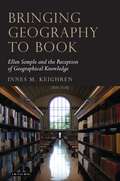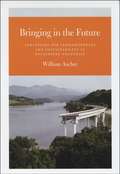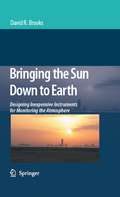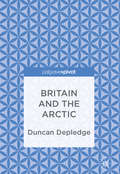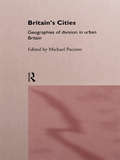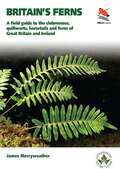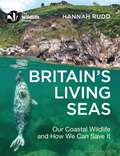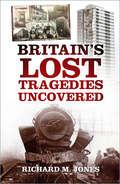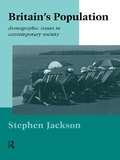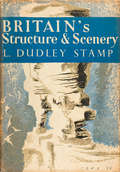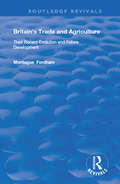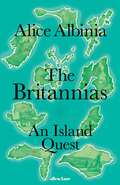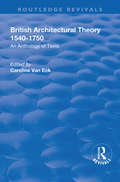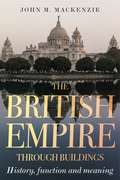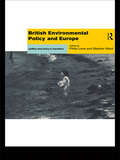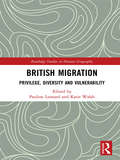- Table View
- List View
Bringing Geography to Book: Ellen Semple and the Reception of Geographical Knowledge (Tauris Historical Geographical Series)
by Innes M. KeighrenThe publication of Ellen Semple's 'Influences of Geographic Environment' in 1911 - a treatise on what would later be called environmental determinism - coincided with the emergence of geography as an independent academic discipline in North America and Britain. A controversial text written by one of America's first female professional geographers, it exerted an important but varied influence on generations of geographers. Some considered it a monument to Semple's scholarship and erudition - a timely manifesto for a scientific approach to human geography. For others, it was conceptually flawed. Accepted by some, repudiated by others, 'Influences' was lauded and criticized in almost equal measure.Innes M. Keighren examines the different reactions to Semple's book. He explains why 'Influences' was encountered differently by different people, at different times and in different places, and reveals why the book aroused the passions it did. Attending to archival records, personal correspondence, published reviews, provenance and marginalia, the author traces a geography of the book's reception and outlines the contribution geography can make to understanding the way knowledge and ideas, in the guise of the printed text, are conceived, transmitted and received. The result is a pioneering work that provides a wholesale re-visioning of the way in which geographical knowledge is disseminated.
Bringing in the Future: Strategies for Farsightedness and Sustainability in Developing Countries
by William AscherHumans are plagued by shortsighted thinking, preferring to put off work on complex, deep-seated, or difficult problems in favor of quick-fix solutions to immediate needs. When short-term thinking is applied to economic development, especially in fragile nations, the results—corruption, waste, and faulty planning—are often disastrous. In Bringing in the Future, William Ascher draws on the latest research from psychology, economics, institutional design, and legal theory to suggest strategies to overcome powerful obstacles to long-term planning in developing countries. Drawing on cases from Africa, Asia, and Latin America, Ascher applies strategies such as the creation and scheduling of tangible and intangible rewards, cognitive exercises to increase the understanding of longer-term consequences, self-restraint mechanisms to protect long-term commitments and enhance credibility, and restructuring policy-making processes to permit greater influence of long-term considerations. Featuring theoretically informed research findings and sound policy examples, this volume will assist policy makers, activists, and scholars seeking to understand how the vagaries of human behavior affect international development.
Bringing in the Future: Strategies for Farsightedness and Sustainability in Developing Countries
by William AscherHumans are plagued by shortsighted thinking, preferring to put off work on complex, deep-seated, or difficult problems in favor of quick-fix solutions to immediate needs. When short-term thinking is applied to economic development, especially in fragile nations, the results—corruption, waste, and faulty planning—are often disastrous. In Bringing in the Future, William Ascher draws on the latest research from psychology, economics, institutional design, and legal theory to suggest strategies to overcome powerful obstacles to long-term planning in developing countries. Drawing on cases from Africa, Asia, and Latin America, Ascher applies strategies such as the creation and scheduling of tangible and intangible rewards, cognitive exercises to increase the understanding of longer-term consequences, self-restraint mechanisms to protect long-term commitments and enhance credibility, and restructuring policy-making processes to permit greater influence of long-term considerations. Featuring theoretically informed research findings and sound policy examples, this volume will assist policy makers, activists, and scholars seeking to understand how the vagaries of human behavior affect international development.
Bringing in the Future: Strategies for Farsightedness and Sustainability in Developing Countries
by William AscherHumans are plagued by shortsighted thinking, preferring to put off work on complex, deep-seated, or difficult problems in favor of quick-fix solutions to immediate needs. When short-term thinking is applied to economic development, especially in fragile nations, the results—corruption, waste, and faulty planning—are often disastrous. In Bringing in the Future, William Ascher draws on the latest research from psychology, economics, institutional design, and legal theory to suggest strategies to overcome powerful obstacles to long-term planning in developing countries. Drawing on cases from Africa, Asia, and Latin America, Ascher applies strategies such as the creation and scheduling of tangible and intangible rewards, cognitive exercises to increase the understanding of longer-term consequences, self-restraint mechanisms to protect long-term commitments and enhance credibility, and restructuring policy-making processes to permit greater influence of long-term considerations. Featuring theoretically informed research findings and sound policy examples, this volume will assist policy makers, activists, and scholars seeking to understand how the vagaries of human behavior affect international development.
Bringing the Sun Down to Earth: Designing Inexpensive Instruments for Monitoring the Atmosphere
by David R. BrooksIn 1998, my colleague, Forrest Mims, and I began a project to develop inexpensive handheld atmosphere monitoring instruments for the GLOBE Program, an international environmental science and education program that began its operations on Earth Day, 1995. GLOBE’s goal was to involve students, teachers, and scientists around the world in authentic partn- ships in which scientists would develop instrumentation and experimental protocols suitable for student use. In return, data collected by students and their teachers would be used by scientists in their research. This kind of collaboration represented a grand vision for science education which had never before been attempted on such a scale, and we embraced this vision with great enthusiasm. Between 1998 and 2006, Forrest Mims and I collaborated on the development of several instruments based on Mims’ original concept of using light emitting diodes as spectrally selective detectors of sunlight, which was first published in the peer-reviewed literature in 1992. These instruments have evolved into a set of tools and procedures for monitoring the transmission of sunlight through the atmosphere, and they can be used to learn a great deal about the composition of the atmosphere and the dynamics of the Earth/atmosphere/sun system. If measurements with these instruments are made properly, they have significant scientific value, as well.
Britain and the Arctic
by Duncan DepledgeBritish interest in the Arctic has returned to heights not seen since the end of the Cold War; concerns about climate change, resources, trade, and national security are all impacted by profound environmental and geopolitical changes happening in the Arctic. Duncan Depledge investigates the increasing geopolitical significance of the Arctic and explores why it took until now for Britain – once an ‘Arctic state’ itself – to notice how close it is to these changes, what its contemporary interests in the region are, and whether the British government’s response in the arenas of science, defence, and commerce is enough. This book will be of interest to both academics and practitioners seeking to understand contemporary British interest and activity in the Arctic.
Britain and the Arctic
by Duncan DepledgeBritish interest in the Arctic has returned to heights not seen since the end of the Cold War; concerns about climate change, resources, trade, and national security are all impacted by profound environmental and geopolitical changes happening in the Arctic. Duncan Depledge investigates the increasing geopolitical significance of the Arctic and explores why it took until now for Britain – once an ‘Arctic state’ itself – to notice how close it is to these changes, what its contemporary interests in the region are, and whether the British government’s response in the arenas of science, defence, and commerce is enough. This book will be of interest to both academics and practitioners seeking to understand contemporary British interest and activity in the Arctic.
Britain's Cities: Geographies of Division in Urban Britain
by Michael PacioneUneven distribution of life is a dominant feature of the city. Major social, economic and spatial divisions are apparent in terms of income and wealth, health, crime, housing, and employment. This text offers an introduction to current processes of urban restructuring, geographies of division and contemporary conditions within the city. The geography of Britain's cities is the outcome of interaction between a host of public and private economic, social and political forces operating at a variety of spatial scales from the global to the local. A deeper understanding of the nature of urban division and of the problems of and prospects for local people and places in urban Britain must be grounded in an appreciation of the structural forces, processes and contextual factors which condition local urban geographies. This book combines structural and local level perspectives to illuminate the complex geography of socio-spatial division within urban Britain. It combines conceptual and empirical analyses from researchers in the field.
Britain's Cities: Geographies of Division in Urban Britain
by Michael PacioneUneven distribution of life is a dominant feature of the city. Major social, economic and spatial divisions are apparent in terms of income and wealth, health, crime, housing, and employment. This text offers an introduction to current processes of urban restructuring, geographies of division and contemporary conditions within the city. The geography of Britain's cities is the outcome of interaction between a host of public and private economic, social and political forces operating at a variety of spatial scales from the global to the local. A deeper understanding of the nature of urban division and of the problems of and prospects for local people and places in urban Britain must be grounded in an appreciation of the structural forces, processes and contextual factors which condition local urban geographies. This book combines structural and local level perspectives to illuminate the complex geography of socio-spatial division within urban Britain. It combines conceptual and empirical analyses from researchers in the field.
Britain's Ferns: A Field Guide to the Clubmosses, Quillworts, Horsetails and Ferns of Great Britain and Ireland (WILDGuides #31)
by James MerryweatherThe only comprehensive photographic guide to the ferns, clubmosses, quillworts and horsetails of BritainThis is a comprehensive, lavishly illustrated and user-friendly photographic identification guide to the fifty-seven ferns and seventeen other pteridophytes that occur in Britain. It is the perfect companion for botanists, naturalists, professional ecologists and anyone else with an interest in this fascinating group of non-flowering vascular plants. Designed to appeal to beginners and experts alike, this authoritative book includes novel identification keys and comparison tables that have been carefully devised to present only essential, easily understood technical terms and descriptions, avoiding jargon as much as possible. Cross-referenced throughout to facilitate the comparison of similar species, this definitive field guide is the go-to source for identifying these species with confidence.Features hundreds of stunning colour photographsComprehensive coverage of Britain's 57 species of ferns, 6 clubmosses, 3 quillworts and 8 horsetailsIncludes novel, easy-to-use, jargon-free identification keys and comparison tablesBeautifully designed, user-friendly and accessible
Britain's Living Seas: Our Coastal Wildlife and How We Can Save It
by Hannah RuddDiscover the incredible diversity of life within our seas and learn how we can all play a role in protecting and conserving it.Our seas are home to an abundance of fascinating creatures and stunning habitats. From spectacular kelp forests to intricate rocky reefs and from mud plains to open ocean, the British Isles have a diversity of marine ecosystems that rival those seen on any nature documentary. Yet, for generations, we have been slowly suffocating life beneath the waves. Decades of unsustainable exploitation, endless pollution and a warming climate have had a devastating effect on our marine habitats.However, it's not too late to make a difference and change course. Written in collaboration with the Wildlife Trusts, Britain's Living Seas provides a user-friendly and richly illustrated guide to coasts around the British Isles, uncovering the diversity of life within a range of marine habitats and the life-giving services that they provide us. Outlining how their very existence is under threat, marine biologist Hannah Rudd presents an alternative and sustainable future for the management of our seas. We can all do our bit as individuals too. Through practical steps such as re-thinking what we eat, our relationship with plastic and how we spend our money, we can become marine conservationists in our everyday lives and help to create a healthier future for our oceans. Everyone can discover more about the wonders within the waters that surround us and play a part in rebuilding our connection with the natural world.
Britain's Living Seas: Our Coastal Wildlife and How We Can Save It
by Hannah RuddDiscover the incredible diversity of life within our seas and learn how we can all play a role in protecting and conserving it.Our seas are home to an abundance of fascinating creatures and stunning habitats. From spectacular kelp forests to intricate rocky reefs and from mud plains to open ocean, the British Isles have a diversity of marine ecosystems that rival those seen on any nature documentary. Yet, for generations, we have been slowly suffocating life beneath the waves. Decades of unsustainable exploitation, endless pollution and a warming climate have had a devastating effect on our marine habitats.However, it's not too late to make a difference and change course. Written in collaboration with the Wildlife Trusts, Britain's Living Seas provides a user-friendly and richly illustrated guide to coasts around the British Isles, uncovering the diversity of life within a range of marine habitats and the life-giving services that they provide us. Outlining how their very existence is under threat, marine biologist Hannah Rudd presents an alternative and sustainable future for the management of our seas. We can all do our bit as individuals too. Through practical steps such as re-thinking what we eat, our relationship with plastic and how we spend our money, we can become marine conservationists in our everyday lives and help to create a healthier future for our oceans. Everyone can discover more about the wonders within the waters that surround us and play a part in rebuilding our connection with the natural world.
Britain's Lost Tragedies Uncovered
by Richard M. JonesIs any disaster really forgotten? It is never forgotten by the survivors who lived through the trauma. It is never forgotten by the emergency services who tried to save the day. It is never forgotten by the relatives of those who never came home. Britain’s Lost Tragedies Uncovered is a look at the tragedies and disasters that may not have stayed in public memory, but are no less terrible than their more famous counterparts. From a late-nineteenth-century family massacre in London to two separate fatal crashes at Dibbles Bridge in Yorkshire, and the worst-ever aviation show crash in post-war Farnborough to the horrifying Barnsley Public Hall disaster – here are twenty-three accounts of true devastation and stunning bravery. They are tales that deserve to be remembered.
Britain's Population: Demographic Issues in Contemporary Society
by Steven JacksonBritain's Population addresses issues relating to the demographic characteristics of British society. Many of the contemporary features of the population relate to changes in the past - particularly the ups and downs in attitudes to marriage and family formation. The history of these trends is considered, including the 'baby boom' of the 1960s when three million children were added to the population within the space of ten years. Jackson argues that the impact of this bulge generation can still be identified and will become of increasing importance when thegeneration reaches retirement age. Current trends in fertility are influenced by the changing structure of the labour market and by the delay in marriage and child bearing to later life. The 1990s has been the era of the 'double income no kids yet' partners and the thirty-something mother. In this book Stephen Jackson highlights how the plight of single mothers, the problem of funding pensioners, and the future of the welfare state, all depend on demographic trends in society.
Britain's Population: Demographic Issues in Contemporary Society
by Steven JacksonBritain's Population addresses issues relating to the demographic characteristics of British society. Many of the contemporary features of the population relate to changes in the past - particularly the ups and downs in attitudes to marriage and family formation. The history of these trends is considered, including the 'baby boom' of the 1960s when three million children were added to the population within the space of ten years. Jackson argues that the impact of this bulge generation can still be identified and will become of increasing importance when thegeneration reaches retirement age. Current trends in fertility are influenced by the changing structure of the labour market and by the delay in marriage and child bearing to later life. The 1990s has been the era of the 'double income no kids yet' partners and the thirty-something mother. In this book Stephen Jackson highlights how the plight of single mothers, the problem of funding pensioners, and the future of the welfare state, all depend on demographic trends in society.
Britain’s Structure and Scenery (Collins New Naturalist Library #4)
by L. Dudley StampBritains Structure and Scenery deals with the physical background, the stage on which the drama of life is played and which provides the fundamental environment for plants, newnaturalists.com
Britain's Trade and Agriculture: Their Recent Evolution and Future Development (Routledge Revivals)
by Montague FordhamPublished in 1932: The author in his Britain's Trade and Agriculture, though almost ruthlessly exposes the fallacies that lie behind the modern accepted views on industry and agriculture, though he obviously writes without desire to attract attention, but simply to clarify facts and to suggest practical solutions.
Britain's Trade and Agriculture: Their Recent Evolution and Future Development (Routledge Revivals)
by Montague FordhamPublished in 1932: The author in his Britain's Trade and Agriculture, though almost ruthlessly exposes the fallacies that lie behind the modern accepted views on industry and agriculture, though he obviously writes without desire to attract attention, but simply to clarify facts and to suggest practical solutions.
The Britannias: An Island Quest
by Alice Albinia'A dazzlingly brilliant book' Hannah DawsonThe Britannias tells the story of Britain's islands and how they are woven into its collective cultural psyche.From Neolithic Orkney to modern-day Thanet, Alice Albinia explores the furthest reaches of Britain's island topography, once known (wrote Pliny) by the collective term, Britanniae. Sailing over borders, between languages and genres, trespassing through the past to understand the present, this book knocks the centre out to foreground neglected epics and subversive voices.The ancient mythology of islands ruled by women winds through the literature of the British Isles - from Roman colonial-era reports, to early Irish poetry, Renaissance drama to Restoration utopias - transcending and subverting the most male-fixated of ages. The Britannias looks far back into the past for direction and solace, while searching for new meaning about women's status in the body politic. Boldly upturning established truths about Britain, it pays homage to the islands' beauty, independence and their suppressed or forgotten histories.
British Architectural Theory 1540-1750: An Anthology of Texts
by Caroline Van EckThis title was published in 2003.Although it is often assumed that British writing on architectural theory really started in the 18th century, there is in fact a large corpus of writing on architecture pre-dating the introduction of Palladianism by Lord Burlington. Some of it, such as the English editions of Serlio and Palladio, belongs to the Vitruvian tradition. But many texts elude such easy classification, such as the prolonged (but hardly studied) discussions on church architecture, which are both in form and content very different from the way that theme was handled in Italian Renaissance treatises. This collection of English writing on architecture from 1540 to 1750 offers a large selection of fragments, some of them never published before. They discuss the nature of architecture, the practicalities of building, the sense of the past, religious architecture and classicism.
British Architectural Theory 1540-1750: An Anthology of Texts (Routledge Revivals Ser.)
by Caroline Van Eck Christy AndersonThis title was published in 2003.Although it is often assumed that British writing on architectural theory really started in the 18th century, there is in fact a large corpus of writing on architecture pre-dating the introduction of Palladianism by Lord Burlington. Some of it, such as the English editions of Serlio and Palladio, belongs to the Vitruvian tradition. But many texts elude such easy classification, such as the prolonged (but hardly studied) discussions on church architecture, which are both in form and content very different from the way that theme was handled in Italian Renaissance treatises. This collection of English writing on architecture from 1540 to 1750 offers a large selection of fragments, some of them never published before. They discuss the nature of architecture, the practicalities of building, the sense of the past, religious architecture and classicism.
The British Empire through buildings: Structure, function, meaning
by John M. MacKenzieBuildings provide tremendous insights into the character of imperialism, not least in the manner in which Western forms were spread across the globe. They reveal the projection of power and authority in colonised landscapes, as well the economic ambitions and social and cultural needs of colonial peoples in all types of colonies. They also represent a colonial order of social classes and racial divisions, together with the ways in which these were inflected through domestic living space, places of work and various aspects of cultural relations. They illuminate the desires of Europeans to indulge in cultural and religious proselytisation, encouraging indigenous peoples to adopt western norms. But the resistance of the supposedly subordinate people led to the invasion, adoption and adaptation of such buildings for a post-colonial world. The book will be vital reading for all students and scholars interested in the widest aspects of material culture.
The British Empire through buildings: Structure, function, meaning
by John M. MacKenzieBuildings provide tremendous insights into the character of imperialism, not least in the manner in which Western forms were spread across the globe. They reveal the projection of power and authority in colonised landscapes, as well the economic ambitions and social and cultural needs of colonial peoples in all types of colonies. They also represent a colonial order of social classes and racial divisions, together with the ways in which these were inflected through domestic living space, places of work and various aspects of cultural relations. They illuminate the desires of Europeans to indulge in cultural and religious proselytisation, encouraging indigenous peoples to adopt western norms. But the resistance of the supposedly subordinate people led to the invasion, adoption and adaptation of such buildings for a post-colonial world. The book will be vital reading for all students and scholars interested in the widest aspects of material culture.
British Environmental Policy and Europe: Politics and Policy in Transition (Global Environmental Change Ser.)
by Philip Lowe Stephen WardThis book explores the effectiveness of the response of environmental groups and organisations in Britain in to the challenges of European integration. Examining the relative European orientation of British environmental policy, and the impact of British concerns on European environmental policy, the book examines issues of environmental diplomacy, institutional dynamics, and policy debates relating to specific concerns such as: * pollution * land use * transport * natural conservation Presenting a wealth of examples throughout, the book draws together contributions from leading academics and practitioners from institutions and organisations such as the DOE, European Commission, WWF and CPRE.
British Migration: Privilege, Diversity and Vulnerability (Routledge Studies in Human Geography)
by Pauline Leonard Katie WalshAround 5.6 million British nationals live outside the United Kingdom: the equivalent of one in every ten Britons. However, social science research, as well as public interest, has tended to focus more on the numbers of migrants entering the UK, rather than those leaving. This book provides an important counterbalance, drawing on the latest empirical research and theoretical developments to offer a fascinating account of the lives, experiences and identities of British migrants living in a wide range of geographic locations across Europe, Asia, Africa and Australasia. This collection asks: What is the shape and significance of contemporary British migration? Who are today’s British migrants and how might we understand their everyday lives? Contributions uncover important questions in the context of global and national debates about the nature of citizenships, the ‘Brexit’ vote, deliberations surrounding mobility and freedom of movement, as well as national, racial and ethnic boundaries. This book challenges conventional wisdoms about migration and enables new understandings about British migrants, their relations to historical privileges, international relations and sense of national identity. It will be valuable core reading to researchers and students across disciplines such as Geography, Sociology, Politics and International Relations.
